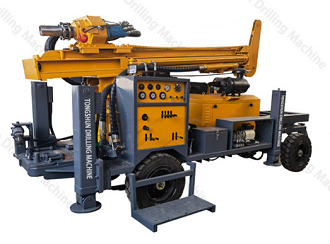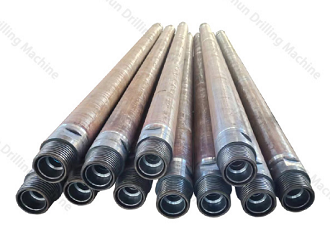Drill pipes play a pivotal and versatile role in drilling and exploring natural resources. Their significance spans various industries, from oil and gas extraction in deep wells to mining operations and geothermal projects. Despite their crucial role, drill pipes often don't receive adequate acknowledgment in conversations concerning essential oilfield equipment.
Whether you’re an industry stakeholder or just curious about the machinery driving resource exploration, this post provides a clear guide to understanding drill pipes and their various functions.
In the realm of drilling, where extracting valuable resources from beneath the Earth's surface is a critical and intricate task, the drill pipe assumes a pivotal role.
A drill pipe is a seamless tube specifically crafted to withstand the harsh and demanding conditions encountered in drilling operations. Its seamless construction ensures durability, reducing the risk of structural weaknesses that could compromise its integrity. These pipes vary in sizes, strengths, and wall thicknesses.
Comprising a significant portion, approximately 95%, of what's known as the 'drill string,' a drill pipe holds a pivotal position in the drilling process.
One crucial attribute of a drill pipe is its hollow interior. This hollow structure is indispensable in drilling operations as it enables the flow of fluids through the pipe.
A drill pipe serves two primary purposes:
1. Torque Transmission: Designed to transmit drilling torque across considerable distances, sometimes spanning multiple miles, from the surface drilling rig down to the drill bit.
2. Fluid Circulation: Acting as a conduit for drilling fluid, commonly known as 'drilling mud,' the drill pipe allows fluid to move from the surface down into the wellbore and back up. This fluid is critical for cooling the drill bit, transporting cuttings to the surface, and maintaining well pressure.
Given the considerable depths plumbed in drilling operations, which can approach nearly 15,000 feet, linking various sections of drill pipe becomes necessary. This connection process typically involves welding threaded tool joints—such as the box tool joint and the pin tool joint—to form a continuous length of drill pipe.
Drill strings refer to the interconnected assembly of diverse components utilized for penetrating the ground or seabed to extract resources. Their length and composition vary based on the depth and intricacy of the drilling operation. Typically, they consist of multiple drill pipes, tool joints, drill collars, and the drill bit itself.
The most prevalent material used for drill pipes is steel, specifically high-strength, low-alloy steel (HSLA). This steel alloy is favored for its capacity to endure the demanding conditions encountered during drilling, including high stress, corrosion, and abrasion.
Occasionally, aluminum is chosen for its lightweight nature. Aluminum pipes are suitable in scenarios where weight plays a crucial role, such as in remote drilling or when adhering to equipment weight limitations.
In certain instances, drill pipes may undergo coating processes involving materials like nickel or other anti-corrosive coatings to offer added protection against corrosion.
Drill pipes exhibit variations designed to suit particular drilling requirements. Among the common types are regular and heavyweight drill pipes, along with spiral pipes that improve torque transmission, and specialized pipes used for directional and horizontal drilling.
Comprehending these diverse drill pipe types holds significance in choosing the appropriate tools and equipment to enhance drilling efficiency and effectiveness across varied geological conditions.
A regular drill pipe, also known as a standard drill pipe, is available in various sizes and outer diameters. The most common outer diameter range for regular drill pipes typically spans from approximately 2 3/8 inches to 6 5/8 inches.
2 3/8”, 2 7/8” and 3 1/2” Drill Pipe for Common Use. In API 5DP specifciations, the common use OD are 2 3/8”, 2 7/8” and 3 1/2” drill pipes, these usually required in large amount of quantities in drilling activities.
Drill pipe can be 18–45 feet long, depending on the type of pipe and the drilling project.
It is typically measured in feet or meters and can vary depending on the specific requirements of a drilling project. Standard lengths for Drill pipe joints are generally 30 feet (9.14 meters) and 45 feet (13.72 meters). These standard lengths are generally utilized in the business because of their flexibility and similarity with most drilling rigs.
Many regular drill pipes feature a center upset or thick wear pads. These components serve to prevent the outer surface of the drill pipe from grinding against the rough walls of the borehole. Center upsets effectively reduce wear and friction, thereby extending the lifespan of the drill pipes.
A heavy-weight drill pipe (HWDP) distinguishes itself with thicker walls and a substantially higher weight per foot (lb/ft) compared to regular drill pipes. These characteristics make HWDP exceptionally well-suited for rigorous drilling applications.
HWDP is engineered to tackle challenges encountered in maintaining borehole control, ensuring wellbore stability, and operating in high-pressure environments during deep drilling. Its increased weight aids in sustaining drilling accuracy.
The strength of a drill pipe varies based on multiple factors like its material, size, and design. Typically crafted from HSLA, drill pipes boast exceptional durability, crucial for withstanding the harsh conditions encountered during drilling operations.
Expressed in terms of tensile strength, drill pipes can range from 100,000 to well over 1,000,000 pounds per square inch (psi), contingent upon the specific type and grade of the pipe. Heavyweight drill pipes (as mentioned earlier) exhibit higher tensile strengths compared to regular ones. A drill pipe's strength is vital for torque transmission, resistance against axial loads, and resilience in diverse geological formations and depths.
Sustaining the longevity and safe functionality of drill pipes in drilling operations necessitates proper maintenance and inspection. Regular upkeep includes cleaning, corrosion protection, and vigilance regarding wear and tear.
Before each use, conducting a comprehensive visual inspection is crucial, looking for cracks, deformations, or any indications of damage. Non-destructive testing methods like magnetic particle testing (MPT) or ultrasonic testing (UT) can be employed to detect internal flaws. Regularly checking threaded connections for wear and ensuring proper lubrication is imperative. Monitoring center upsets and wear pads also aids in preventing excessive friction and extends the drill pipe's lifespan.
Determining the proper drill pipe for your drilling project can be a difficult choice to make. Luckily, our drilling experts are available to answer questions on your drilling tool selection. Give us a call for answers today!


Copyright © Jinzhou City TongShun Drilling Machine Co.,Ltd. All Rights Reserved Sitemap | Powered by 